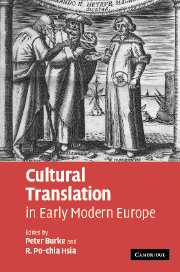Book contents
- Frontmatter
- Contents
- Notes on contributors
- Introduction
- PART I TRANSLATION AND LANGUAGE
- PART II TRANSLATION AND CULTURE
- PART III TRANSLATION AND SCIENCE
- 9 The role of translations in European scientific exchanges in the sixteenth and seventeenth centuries
- 10 Scientific exchanges between Hellenism and Europe: translations into Greek, 1400–1700
- 11 Ottoman encounters with European science: sixteenth- and seventeenth-century translations into Turkish
- 12 Translations of scientific literature in Russia from the fifteenth to the seventeenth century
- Bibliography
- Index
11 - Ottoman encounters with European science: sixteenth- and seventeenth-century translations into Turkish
Published online by Cambridge University Press: 27 July 2009
- Frontmatter
- Contents
- Notes on contributors
- Introduction
- PART I TRANSLATION AND LANGUAGE
- PART II TRANSLATION AND CULTURE
- PART III TRANSLATION AND SCIENCE
- 9 The role of translations in European scientific exchanges in the sixteenth and seventeenth centuries
- 10 Scientific exchanges between Hellenism and Europe: translations into Greek, 1400–1700
- 11 Ottoman encounters with European science: sixteenth- and seventeenth-century translations into Turkish
- 12 Translations of scientific literature in Russia from the fifteenth to the seventeenth century
- Bibliography
- Index
Summary
A scholarly community seems to have gradually emerged in Anatolia as Turkomans settled in the region from the eleventh century onwards. The medreses, the schools (mainly teaching Islamic theology and Muslim jurisprudence) established between the twelfth and fourteenth centuries by the Seljuks, introduced Islamic religious and scientific culture to the Anatolian towns. These educational institutions created on the model of the Nizamiye medreses, named after their founder the Seljuk vizier Nizamulmulk (reigned 1063–92), were widespread in the eastern part of the Islamic world.
The rulers of the Turkish principalities that surfaced after the Seljuk state weakened and collapsed carried on the tradition of founding medreses where Islamic scientific culture flourished. The Ottoman state that emerged at the turn of the fourteenth century was one of these principalities and it welcomed and championed Islamic scientific culture until the nineteenth century, when science and technical knowledge transferred from Western Europe were finally taught in Ottoman educational institutions. Translations played a significant role not only in the introduction of the Islamic scientific knowledge that had developed between the ninth and fourteenth centuries, but also in transmitting science from Western Europe.
Ottoman scholarly life would thus evolve under the influence of two distinct cultures. While Islamic scientific culture dominated up to the end of the eighteenth century, Western European scientific and technical knowledge penetrated Ottoman space through translations and other means from the sixteenth century onwards.
- Type
- Chapter
- Information
- Cultural Translation in Early Modern Europe , pp. 192 - 211Publisher: Cambridge University PressPrint publication year: 2007
- 3
- Cited by



